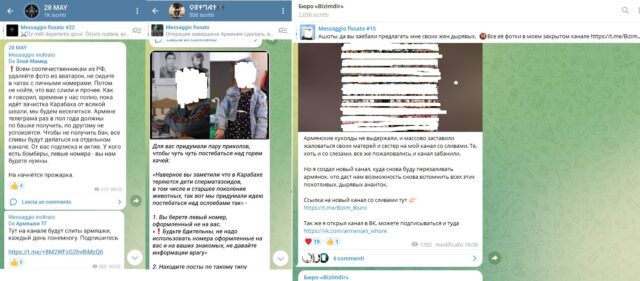OSINT Report: Nagorno-Karabakh Crisis, Armenophobia and the so-called ‘Azerbaijani Telegram Channels’ in Russian language

Geopolitical Report ISSN 2785-2598 Volume 34 Issue 8
SpecialEurasia OSINT Unit
The Azerbaijani military offensive against Nagorno-Karabakh has caused a severe humanitarian crisis, causing a significant exodus of Armenian civilians. This mass departure is rooted in a prevailing apprehension amongst Armenians towards living under the governance of Baku.
Despite recurrent assertions by Azerbaijani authorities of their commitment to fostering a multicultural and multiethnic tolerant society, evidence might suggest a dissonance with this stated aim.
Our OSINT report, grounded in openly available sources and public information, shows that a segment of Azerbaijani society or Azeri Diaspora in the post-Soviet Space on different Telegram channels in the Russian language exhibits pronounced sentiments of Armenophobia, manifesting in a discernible hostility towards Armenians in occasion of the Nagorno-Karabakh crisis.
This deep-seated animosity poses a arduous challenge to the prospect of harmonious cohabitation between Azeri and Armenian populations in the contested region of Nagorno-Karabakh.
Nagorno-Karabakh Crisis: Background Information
The Azerbaijani military offensive in Nagorno-Karabakh marked a pivotal moment, culminating in the capitulation of Stepanakert and, consequently, the dissolution of the Republic of Nagorno-Karabakh/Artsakh after over three decades.
This event has reverberated geopolitically, particularly considering Russia’s stance towards the Armenian population in Nagorno-Karabakh. The regional dynamics have undergone a significant transformation, with Baku now firmly in control of the territory.
This shift has given rise to a pressing humanitarian crisis, one that some regional experts and media and Armenian authorities have characterised as a potential instance of ethnic cleansing orchestrated by the Azerbaijani authorities. The prevailing sentiment is that the Armenians of Nagorno-Karabakh may face considerable challenges in coexisting with Azeri counterparts under Baku’s rule, owing to the pervasive Armenophobia within Azerbaijan.
Amidst the aftermath, Baku and Azerbaijani officials have consistently asserted that Azerbaijan upholds a commitment to being a multicultural and multiethnic nation.
They contend that claims of Armenophobia are baseless allegations fabricated by Yerevan to tarnish the reputation of the Azerbaijani people. Conversely, there is discourse surrounding ‘Azerbaijanphobia’, representing a reciprocal sentiment of antipathy towards Azerbaijan.
This sentiment has been cultivated over the years, according to some Azerbaijani statements, fuelled by misinformation disseminated by Armenia and its diaspora. The resulting narrative is a complex web of perceptions, ultimately influencing regional dynamics and international relations.
In this atmosphere of contrasting narratives, the international community must engage critically with the intricate socio-political dynamics in action. The Nagorno-Karabakh Crisis underscores the need for a nuanced understanding of historical grievances, geopolitical interests, and the impact of disinformation campaigns on the perceptions and attitudes of both Armenians and Azeris.
This initial report, grounded in publicly available sources, endeavours to shed light on the crucial query: “Can Armenians and Azeris coexist harmoniously in Nagorno-Karabakh, and does Armenophobia within Azerbaijani society warrant international concern?”
Admittedly, it is imperative to acknowledge that this report draws from a limited pool of sources and evidence, rendering it inherently non-exhaustive and unable to encapsulate the entirety of Azerbaijani society.
Nevertheless, it underscores a disconcerting trend and prevailing attitude that demands the attention of Baku’s authorities, particularly if they are genuinely committed to cultivating a multicultural and multiethnic society.
Moreover, it is crucial to note that this report does not want to determine whether Armenophobia solely originates from individual perceptions within Azerbaijani society or if the authorities in Baku systematically fostered it over the years. This nuanced distinction bears significant implications for comprehending the broader socio-political landscape in the region.
Open Sources and Information from Azerbaijani Telegram Channels
On the fateful Monday, September 25th, 2023, a devastating explosion rocked a fuel depot in Stepanakert, Nagorno-Karabakh, resulting in a staggering toll of at least 20 lives lost and nearly 300 individuals grievously wounded.
The immediate aftermath witnessed a swift and coordinated response from emergency personnel, who diligently transported 290 patients, afflicted with varying degrees of burns, to four distinct medical facilities, as confirmed by the Health Ministry of Nagorno-Karabakh.
In this case, our monitoring of open sources revealed a concerning trend: a proliferation of jokes surrounding this tragic incident across various Azeri telegram channels. Recognising the gravity of this matter, we have embarked on a thorough investigation into this phenomenon.
Our investigation has revealed disturbing content emanating from the Telegram Channel ‘Zloy Mamed’, boasting over 13,000 followers among the Azeri Diaspora in the Russian Federation and the post-Soviet space since the common language is Russian. This channel has brazenly disseminated images equating the tragic explosion in Stepanakert to a barbecue featuring Armenian individuals.

Delving further into our probe, we unearthed the existence of an extensive network of Telegram Channels, all propagating a strain of hatred directed towards Armenia, exemplifying a concerning strain of Armenophobia. This network’s activities include cold-heartedly jesting about the humanitarian crisis plaguing the inhabitants of Nagorno-Karabakh, subjecting Armenian women to harassment, and in certain cases, producing explicit content. Moreover, they exploit this dire situation to instil widespread panic and distress within the Armenian populace.

Our investigation has uncovered content disseminated by the Telegram Channel ‘Kazanova Live’, which published a joke equating Armenian victims of the explosion in Stepanakert to a kebab. This reprehensible act is further compounded by the actions of channels like ‘Bez Masok v.42.1’, which propagated a link titled ‘Armenian prostitutes for Azeri people’.
As of recent, this channel has restricted access, now only available to premium members, although it remained openly accessible until yesterday. This channel has not only shared personal information of Armenian women, including names, surnames, ages, and phone numbers gathered from open sources, but has also featured explicit material, the authenticity of which is difficult to ascertain, purportedly depicting naked Armenian women.

Another Telegram Channel, ‘Biuro Bizimdir’ informed its community that there is a VK page called Armjanskie devushki dlja Mamedov (Armenian girls for Mamed) which explains in its About section that “Armenian girls are created for cocky Azerbaijanis (Mameds). An Armenian woman should not be shy to please her master Mamed! Armenian means wxxxe, sxxt, cxxxxxxr and slave.”

Apart from pornography and hate speech against Armenian women, the Telegram Channel ‘Kafir Union Archive’ shared pictures of Armenian people of Nagorno-Karabakh exhibiting hate and anger. It is important to note that the term kafir comes from an Islamic term which, in the Islamic culture, refers to a person who disbelieves in God as per Islam, denies his authority, or rejects the tenets of Islam.
The unfolding humanitarian crisis, stemming from the Azerbaijani military offensive in Stepanakert, has left a distressing number of civilians unaccounted for. A Telegram channel advocated for the dissemination of false information regarding the tragic demise of Armenian children, with the intent of sowing panic and disarray among the populace.
Furthermore, the same channel, ‘Zloy Mamed’, has advised its followers in the Russian Federation to adopt false identities and purge their mobile phones of any incriminating images. The channel’s proprietor callously remarked, “we have plenty of time, while Karabakh is being cleared of all trash, we will have fun.”

OSINT Report: Conclusion
This report presents a selection of evidence and sources in the Russian language gathered within the past few hours. It is essential to emphasise that the behaviours and attitudes observed on these social media platforms do not indicate the entirety of Azerbaijani society and might probably concern the Azeri Diaspora or other segment of the population in Russia and the post-Soviet space.
Rather, they are potentially attributed to only about 10-15 thousand accounts, as per our findings from the reported Telegram channels. While this may constitute a relatively minor segment of the broader Azerbaijani populace or Azeri Diaspora, it underscores a troubling trend that requires immediate attention from Baku and also other authorities in the post-Soviet space to curb the proliferation of Armenophobia.
It is worth contemplating the possibility that individuals belonging to diverse ethnic groups or backgrounds have established Telegram channels with the intent of exacerbating instability in the South Caucasus and fomenting discord between Armenia and Azerbaijan. Consequently, vigilant observation of the situation in the region is imperative in order to ascertain whether sentiments against Armenians are confined solely to a specific segment of social media or extend beyond it.
Given that these Telegram channels predominantly communicate in the Russian language and allude to Armenian individuals residing in the Russian Federation, this could potentially raise concerns for the Kremlin regarding the coexistence of Armenians and Azerbaijanis within the diverse and multiethnic Russian society.
Moreover, considering the prevailing unfavorable sentiment among most Armenians towards Moscow, who are critical of what they perceive as abandonment of Nagorno-Karabakh, it would be prudent for the Kremlin to exert control over the situation in order to avert internal discord. This proactive approach would serve to maintain stability within the Russian Federation and safeguard the living conditions of its various ethnic and cultural communities.
Moreover, it is crucial to draw a connection between the content disseminated on these platforms and the distressing events of the 2020 Nagorno-Karabakh conflict or in Azerbaijani military offensive against Armenia in September 2022. During that period, distressing videos and images surfaced, depicting Azeri soldiers engaging in acts of mutilation and beheading against Armenian soldiers.
This stark reminder of the atrocities witnessed in the recent past further emphasises the gravity of the situation and the pressing need for comprehensive action to address these deeply concerning behaviours.
The parallels between the current scenario and the 2020 Nagorno-Karabakh conflict illuminate a disconcerting pattern of dehumanising behaviour and a troubling disregard for human dignity. The recurrence of such acts demands a resolute response from both international bodies and regional authorities to ensure that these trends are promptly addressed and that measures are taken to prevent any further escalation.
Disclaimer: The above statement is provided for informational purposes only and is not intended to make any conclusive allegations or accusations against the Government of Baku, the Azerbaijani society or the Azeri Diaspora as a whole. The use of the label “Azerbaijani telegram channel” is based on observable attributes, and it does not imply direct endorsement or support from any official entity. It is important to recognise that not all Azerbaijani individuals or groups harbor animosity towards Armenians, and this report does not assert such a stance. Instead, the report aims to highlight a discernible trend in certain Telegram Channels and suggests vigilance to both the international community and local authorities regarding potential risks associated with these viewpoints.
The disclosure of images in this context is solely intended for evidentiary purposes and does not constitute an endorsement or approval of the behavior depicted. To maintain privacy and respect for individuals involved, sensitive data and the faces of people in the images have been intentionally obscured. This measure has been taken with the intention of safeguarding the privacy and dignity of those featured in the pictures. It is important to approach the content with sensitivity and an understanding of the context in which it is presented.
Do you like SpecialEurasia reports and analyses? Has our groundbreaking research empowered you or your team? Now is your chance to be a part of our mission! Join us in advancing independent reporting and unlocking the secrets of Eurasia’s complex geopolitical landscape. Whether through a one-time contribution or a monthly/yearly donation, your support will fuel our relentless pursuit of knowledge and understanding. Together, let’s pave the way for a brighter future. DONATE NOW and secure your place in shaping the geopolitical narrative. to improve it.
